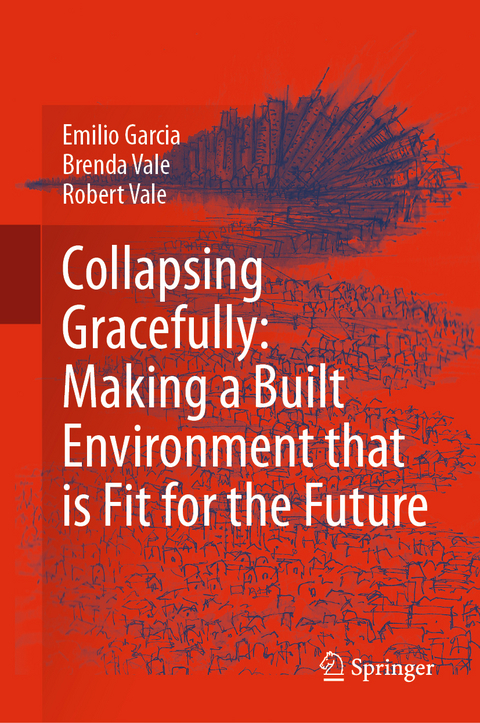
Collapsing Gracefully: Making a Built Environment that is Fit for the Future
Springer International Publishing (Verlag)
978-3-030-77782-1 (ISBN)
This innovative book investigates the concept of collapse in terms of our built environment, exploring the future transition of modern cities towards scenarios very different from the current promises of progress and development. This is not a book about the end of the world and hopeless apocalyptic scenarios. It is about understanding change in how and where we live. Collapse is inevitable, but in the built environment collapse could imply a manageable situation, an opportunity for change or a devastating reality.
Collapsing gracefully means that there might be better ways to coexist with collapse if we learn more about it and commit to rebuild our civilisations in ways that avoid its worst effects. This book uses a wide range of practical examples to study critical changes in the built environment, to contextualise and visualise what collapse looks like, to see if it is possible to buffer its effects in places already collapsing and to propose ways to develop greater resilience.
The book challenges all agents and institutions in modern cities, their designers and planners as well as their residents and users to think differently about built environment so as to ease our coexistence with collapse and not contribute to its causes.
.
Emilio Garcia is an architect and urban designer. Since 2013 he has been working as a Lecturer in sustainability and resilience at the School of Architecture and Planning in The University of Auckland, New Zealand. He has also practised and taught in Mexico and Argentina and won a Holcim Award for Sustainable Construction in 2008. His latest book (with Brenda Vale) "Unravelling sustainability and resilience in the built environment" (Routledge, 2017) explores the meaning of applications of these terms and why they are still important for designers. Brenda Vale and Robert Vale are architects and academics. They wrote their first book on sustainable design, "The Autonomous House", in 1975. Following their design of several award winning sustainable commercial buildings in the UK they went on to design and build the UK's first autonomous house in 1993 and the first zero-emissions settlement in 1998. They have received international recognition, including awards from the United Nations and the European Solar Energy Society. More recently they developed the Australian government's National Australian Built Environment Rating System (NABERS) which has now been put into operation. Recent environmental books include "Time to Eat the Dog? The real guide to sustainable living", which analysed the impact on the environment of a western life-style and things people do every day, and "Living within a Fair Share Ecological Footprint" which has chapters written by many of their former and existing postgraduate students. Their most recent book is "Architecture on the Carpet" which explores the links over the last hundred years between architecture and construction toys such as Meccano and Lego.
What Do We Mean by Collapsing Gracefully?.- Current Ideas for Future Built Environments.- What Can We Learn From the Collapse of Societies in the Past?.- The Modern Built Environment and its Relationship to Collapse.- Technology and Collapse.- A Case Study of Technology and Climate Change.- Inequality, Collapse and the Built Environment.- Inequality in the Urban Landscape of New Zealand: From the Country to the Plot.- Growth and Collapse.- Growth and Resources.- Epidemics, Pandemics, and Collapse.- The Architecture of Wealth.- What Should We Do?
"The authors take their readers on a journey ... a well-rounded exploration of the issues, both past and present ... . Collapsing Gracefully encourages architects, designers and those in the construction industry to reflect on what we consider to be best for the built environment ... . I thoroughly enjoyed Collapsing Gracefully. Regardless of your background, the book offers a great opportunity in which to stop and reflect on your work and consider its wider impacts." (James McLean, Architecture New Zealand, March - April, 2022)
“The authors take their readers on a journey … a well-rounded exploration of the issues, both past and present … . Collapsing Gracefully encourages architects, designers and those in the construction industry to reflect on what we consider to be best for the built environment … . I thoroughly enjoyed Collapsing Gracefully. Regardless of your background, the book offers a great opportunity in which to stop and reflect on your work and consider its wider impacts.” (James McLean, Architecture New Zealand, March - April, 2022)
| Erscheinungsdatum | 27.07.2021 |
|---|---|
| Zusatzinfo | XIX, 310 p. 79 illus., 32 illus. in color. |
| Verlagsort | Cham |
| Sprache | englisch |
| Maße | 155 x 235 mm |
| Gewicht | 619 g |
| Themenwelt | Naturwissenschaften ► Biologie ► Ökologie / Naturschutz |
| Sozialwissenschaften ► Politik / Verwaltung ► Staat / Verwaltung | |
| Technik ► Architektur | |
| Technik ► Elektrotechnik / Energietechnik | |
| Schlagworte | Built Environment • climate change • Climate Change and Built Environment • Collapse Theory • Growth and Built Environment • Inequality in Built Environment • Mitigating Climate Change • Pandemics and Built Environment • Resilience and Built Environment • sustainable cities • Technology and Growth • Urban sustainability • Wealth and Built Environment • Wealth and Climate Change • Wealth distribution |
| ISBN-10 | 3-030-77782-0 / 3030777820 |
| ISBN-13 | 978-3-030-77782-1 / 9783030777821 |
| Zustand | Neuware |
| Haben Sie eine Frage zum Produkt? |
aus dem Bereich


